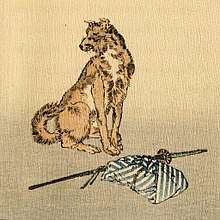Shippeitaro

Shippeitaro[1] or Shippei Taro[2] (also given by the German spelling Schippeitaro) is the name of a helper dog in the Japanese fairy tale by the same name.
Translations include "Schippeitaro" in Andrew Lang's Violet Fairy Book (1901), taken from a German copy, and Mrs. James's "Schippeitaro", printed in 1888. They share the same plotline down to the details, with the dog helping to eradicate the mountain spirit and its minions in that appear in the guise of cats.
In most instances of the tale, the dog is brought to defeat demons or ogres in the form of monkeys, such as in "Shppei Taro" printed in Keigo Seki's anthology translated into English in 1963.
Translations
The version of "Schippeitaro" in Andrew Lang's The Violet Fairy Book (1901) was taken from Japanische Märchen und Sagen collected by Professor David Brauns (Leipzig, 1885).[3][4][lower-alpha 1]
The story of "Schippeitaro" (1888) as told by Mrs. T. H. James (Kate James[6]), was number 17 in the "Japanese Fairy Tale Series" printed by Hasegawa Takejirō, who issued many such chirimen-bon or "crepe-paper books".[7] Mrs. James's version follows a storyline identical to Lang's version.[8]
Synopsis
Below is the summary of the Lang/Mrs. James version:[9][10]
A young warrior wandered the land in search of adventure, eventually finding an enchanted forest, wherein he slept in a shrine (or chapel).[11] He was awoken at midnight by ferocious yowls from cats, who were dancing and yelling, some saying, "Do not tell Shippeitaro!" He got up and continued on, eventually finding a village where he heard a female voice lamenting and pleading for help. He was told that every year they had to sacrifice a maiden to the spirit of the mountain, and it was this girl's turn this year. She was put in a cage (or cask) which, in turn, was put in the shrine.[lower-alpha 2] He inquired about Shippeitaro: a dog of the prince's overseer,[lower-alpha 3] living nearby. The warrior visited the overseer and persuaded him to lend him the dog. He went to the cage, replacing the maiden with Shippeitaro. The cage was brought to the shrine, and the cats came. A huge black cat opened the cage, and Shippeitaro jumped out and killed it. Then, with the help of the warrior, killed several others before they fled. The warrior brought Shippeitaro back to his owner in the morning, and every year a feast was held in honor of the warrior and Shippeitaro.[lower-alpha 4]
Variants
The Lang/Mrs. James version which features cats as the antagonists is actually atypical. In most Shippeitaro tales, the evil-doers are monkeys (or baboons).[13][lower-alpha 5]
An example is "Shippei Taro" published in Keigo Seki (ed.), Robert J. Adams (tr.), Folktales of Japan (1963), which was collected in Monou District, Miyagi. The priest in the story defeated the ogres (whose remains were those of dead monkeys) by replacing the young girl placed in the chest to be sacrificed with the dog Shippei Taro, which he found far away in Nagahama of Ōmi Province.[lower-alpha 6][15][16]
Explanatory notes
- ↑ Lang in the Violet Fairy Book only cites "Japanische Märchen",[3] but in his Pink Fairy Book (1897), he provides the longer and fuller citation naming Brauns.[5]
- ↑ Brauns writes Käfig "cage", concurring with Mrs. James's rendition as "cage". This in Japanese would be kago (籠),[12] which can also denote a basket, including those with lids. The illustration in Mrs. Smith's book (drawn by Suzuki Munesaburo) depicts such a lidded basket (Cf. also kōri (行李) or wicker trunk). Lang for some reason rendered this as "cask", which was illustrated as a barrel by Henry Justice Ford.
- ↑ "the head man of our Prince", in Mrs. James's text
- ↑ Mrs. Smith's version simply concludes with the warrior seeking new adventures.
- ↑ Seki also gives monkey in the main, with cat, rat, badger as subtypes.[14]
- ↑ "Collected in Mono-gun, Miyagi-ken by Keisuke Sugawara" (Seki 1966, p. 33)
References
- Citations
- ↑ James (1888), Preface
- ↑ Seki (1963), p. 33
- 1 2 Lang (1901), p. 40.
- ↑ Brauns (1885), pp. 50–53 (Fraktur font); Schippeitaro (in Latin font online at zeno.org).
- ↑ Lang, Andrew, ed. (1897), "Uraschimataro and the Turtle", The Pink Fairy Book, New York and Bombay: Longmans, Green, p. 25n
- ↑ Sharf (1994), p. 10
- ↑ Sharf (1994), p. 62
- ↑ Cf. the text itself: James (1888)
- ↑ Lang (1901), pp. 36–40 (Violet Fairy Book)
- ↑ James (1888), James (1889)
- ↑ Mrs. Smith calls it "little temple" or "ruined shrine", in contrast to Brauns's Kapelle and Lang's "chapel" which have Christian connotation.
- ↑ Kobayashi (2012), p. 84
- ↑ Kobayashi (2012), p. 81
- ↑ Seki (1966), p. 52
- ↑ Seki (1963), pp. 33–36
- ↑ Hansen, William F. (2002), Ariadne's Thread: A Guide to International Tales Found in Classical Literature, Cornell University Press, pp. 120–121
- Bibliography
- Brauns, David, ed. (1885), "Schippeitaro", Japanische Märchen und Sagen, Leipzig: Wilhelm Friedrich, pp. 50–53 (in German)
- James, Mrs. T. H. (1888), Schippeitaro (PDF), Japanese Fairy Tale Series (17), Suzuki Munesaburo (illustr.), Kobunsha
- James, Mrs. T. H. (1889) [1888], Schippeitaro, Japanese Fairy Tale Series (17), Suzuki Munesaburo (illustr.), Kobunsha
- Kobayashi, Koichiro (小林光一郎) (2012), Chirimenbon Shippeitaro ni arawareru Odoru Neko ちりめん本『竹篦太郎』に表れる「踊る猫」 [Dancing cats evident in the chirimen-book Shippeitaro] (PDF), Institute for the Study of Japanese Folk Culture Kanagawa University (Research Center for Nonwritten Cultural Materials) (in Japanese)* Lang, Andrew, ed. (1901), "Schippeitaro", The Violet Fairy Book, New York and Bombay: Longmans, Green, pp. 36–40
- Sharf, Frederic Alan (1994), Takejiro Hasegawa: Meiji Japan's Preeminent Publisher of Wood-block-illustrated Crepe-paper Books, Peabody Essex Museum Collections, vol. 130, Salem: Peabody Essex Museum
- Seki, Keigo, ed. (1963), Robert J. Adams (tr.), "Shippei Taro", Folktales of Japan, University of Chicago Press, pp. 33–36
- Seki, Keigo (1966), Types of Japanese Folktales, Society for Asian Folklore, pp. 52–